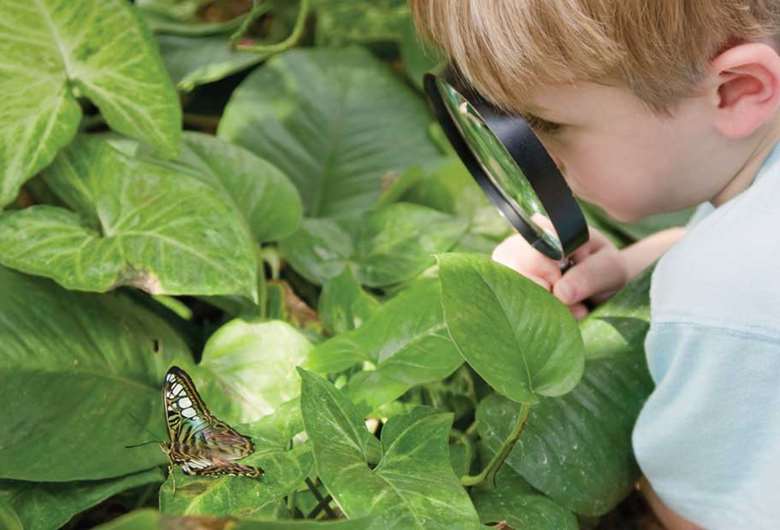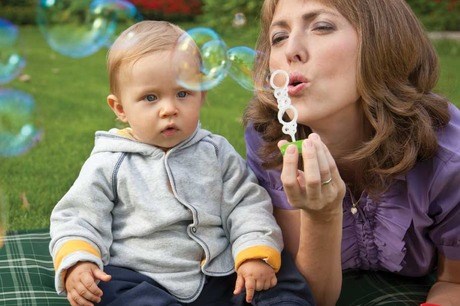Home Learning: Activities - Early Science
Ruth Thomson
Monday, September 22, 2014
From early in their lives, children show an interest in science. They often notice things that we as adults take for granted, such as the clouds in the sky or how the pedal on the kitchen bin works.

While there are times when most parents find their children's interest in objects frustrating or untimely, it is worth fostering when you can. This is because observing and touching objects and exploring concepts can help children's thinking skills.
Here are some simple ways in which you can build on your child's interest in the world around them.
HARD AND SOFT
From six months
One of the ways that babies will learn about the world is through touching things and putting them in their mouths. Choose some objects that are either hard or soft for your child to explore. A scarf, a cake tin or a natural sponge would work well.
When choosing objects, make sure that they are clean and can't be swallowed or choked on. You could ask your early years practitioner for more ideas, as most settings will give babies natural objects to play with. Sit with your baby and watch as the objects are picked up and explored.
How this activity helps your child
Hand movements: Lifting and exploring objects will help your child to strengthen their hand movements.
Vocabulary: If you can point and say the name of the objects as your baby lifts them, your baby will start to recognise the names of objects.
Balance: Lifting objects requires a lot of balance and overall co-ordination.
What next?
Give your child some contrasting objects to feel, such as wooden spoons and metal spoons.
IN AND OUT
From 12 months
Toddlers are usually interested by the relationship between objects and space. It is common to find them taking things in and out of cupboards or opening and shutting boxes.
It is worth looking out for a cardboard tube from, for example, a kitchen roll; hold the tube and drop an object such as a teaspoon down it. Watch as your child then tries to repeat the action.
If your child is interested, try making a wider tube by rolling up a magazine so that they can experiment with a wider range of objects such as balls or toy cars.
How this activity helps your child
Co-ordination: This activity will help to develop your child's co-ordination as they retrieve the dropped objects.
Mathematics: Your child will learn about size, as there may be times when some objects will not fit down the tube.
Language: This type of activity will help your child learn and use words such as 'roll', 'down' and 'gone'.
What next?
Find saucepans with lids or small cardboard boxes with lids so that your child can enjoy putting things inside and then taking them out.
BUBBLES

From two years
Most children love playing with bubbles - catching them or watching them. Interestingly, bubbles twist in the air and it is impossible to blow a square one.
Look out for some bubble mixture or make your own using a little washing up liquid and water. Blow bubbles for your child to catch, but also talk to them about how many there are and their size.
Let your child have a go at blowing bubbles. Remember to hold the container with the bubble mixture in it, as it can get spilt by accident.
How this activity helps your child
Co-ordination: By catching but also blowing bubbles, your child's co-ordination will be developed.
Mathematics: This can be an opportunity to count and to talk about size.
Confidence: By blowing their own bubbles or popping bubbles, children gain confidence in their own skills.
Next steps
Try blowing a huge bubble by dipping the end of a funnel in the bubble mixture. Your child might be able to do this for themselves at around three years old.
IN THE GARDEN OR PARK
From three years
There is plenty for children to look at outdoors. Next time you are outdoors, encourage your child to look carefully at the plants and small insects.
Point out how a leaf has veins or how a spider attaches its web to several anchor points. Follow the flight of a bee (at a safe distance) and watch how it moves from flower to flower.
As well as helping your child to observe things that you have noticed, look at the things that they seem to think are of interest.
How this activity helps your child
Language: Time spent pointing and naming objects will help your child to learn new words.
Physical development: Standing still is a skill that takes time for children to develop and is linked to co-ordination.
Mathematics: Nature is full of shapes, sizes and patterns, which in turn link to mathematical concepts.
Next steps
Try learning a few names of plants, insects or birds so that you can pass your knowledge on to your child.
WINDMILLS
From four years
A windy day is a great opportunity to make items that move in the wind. Try making a windmill with your child using a square of paper.
Once your child has decorated it with stickers, felt tips or crayons, fold it diagonally in two directions. Then cut three quarters of the way towards the centre along each of the lines. Place four alternate corner sections in the centre before putting a sticker on top to hold them in place.
Attach it to a wooden fence or a stick using a drawing pin, but do make sure that it is secure.
How this activity helps your child
Creativity: Decorating the paper can help your child be creative.
Social development: Your child will learn to collaborate by working with you on this project.
Technology: Activities that involve making things can help your child become interested in technology.
Next steps
Your child might like to attach different types and widths of fabric to a line, to watch which one moves in the wind most easily.
CHEESE ON TOAST
From four years
There is plenty of science when it comes to cooking, especially when food changes colour or shape in the cooking process. There are many simple cooking activities that you can do with your child. A good example is cheese on toast.
Under supervision, your child can grate some cheese onto a slice of bread and then watch it melt and bubble under the grill. When it is cooler, let them sample it.
Together, you can experiment with different sizes of bread and see if there is a difference in the time they take to cook.
How this activity helps your child
Mathematics: If you use a timer to measure how long it takes to cook the cheese on toast, your child can learn about time.
Language: Cooking together will give your child a lovely opportunity to chat with you
Confidence: This activity will help your child gain some new skills and this in turn will help their confidence.
Next steps
Try a recipe involving a different ingredient such as jacket potato. Use it to show heat changes the structure and texture of the potato.




